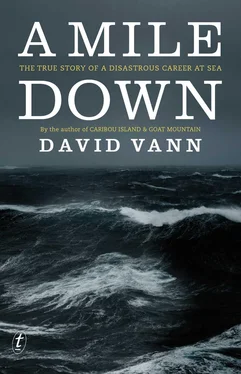On the other side of our concrete finger, megayachts were tied stern-to, their bows facing into the wind, held by double anchors. We watched one of these, a hundred-foot motoryacht, slip back and grind its stern against the concrete, which bit deep into its fiberglass. My crew and I ran over to help, trying to put fenders between the boat and the dock and yelling over the wind for the yacht’s crew. They couldn’t hear us, but they could feel and hear the grinding from inside. They came running out, fired up the engines, and put out more fenders, but the forces were enormous.
We had visitors day and night from the dozen or so fifty-foot fiberglass yachts that were downwind of us. If our lines failed, we would, in a matter of seconds, be blown across about fifty feet of water and pulverize all of those little boats, many of which had cost between $300,000 and $600,000. So their owners took a special interest in our lines and how they were secured and whether they would hold. They were of the opinion, of course, that our lines were not thick enough, and they hassled me so continuously I finally went to Sheppard’s and paid more than $300 for two twenty-five-foot lines. It was a waste of money, but I was under a lot of pressure, from the marina as well as from the boat owners. So in the end we had almost thirty lines holding us to the dock, including two of the thickest that could be purchased in Gibraltar, and though we were heeled over in the wind and bouncing in the waves, we held.
When the winds finally died down, we had been delayed a full week, and another storm was supposed to come soon. A weather window of three or four days, long enough for us to get clear of the area, was predicted, so I decided to make a dash for it.
WE WATCHED THE Pillars of Hercules passing astern and followed the African shoreline. After an hour or two, we hit large standing waves, almost twenty feet high. We weren’t in the mouth of the strait anymore, but even this far out, the tremendous volume of water draining from the Mediterranean to meet Atlantic swells was causing the same kind of standing waves I had seen while rafting Alaskan rivers with my father. They’re called standing waves because they stay in one place, where the collision of forces causes them. In rivers, they’re behind underwater boulders. In the ocean, they’re at the meeting point of opposing currents, usually over shallower water. They’re extremely dangerous not just from overall height but from how steep they are and how close together, and I could not avoid them. Even in a ninety-foot sailing yacht, the force of the waves was frightening.
Luckily we had strong engines and were through quickly. By late afternoon, we cleared the lighthouse on the final point. The hills were lush and green, not quite how I had imagined Morocco. But the water was bright turquoise, the air warm. The African coast would fall steadily away to port, and we’d be in the Canary Islands in three or four days. We couldn’t raise our sails yet, since the wind was straight on our nose, but after the Canaries we could run downwind all the way to Mexico. And we’d be arcing south, to catch the tradewinds, so we’d soon be able to trade our foul-weather gear for shorts and T-shirts.
That evening the seas increased a bit and the ride was bouncy, but at the time I went below to sleep we were still making 11 knots, very fast time, plowing into each wave with a concussion that sent spray over the pilothouse. All systems were checking out perfectly and the crew were in high spirits.
I fell asleep with Nancy in one of the aft staterooms but was awakened suddenly by a loud metallic popping sound right underneath us. I checked my watch to see it was 1:33 A.M. When things go seriously wrong, you have to keep track of the time.
In the ten seconds it took me to run up on deck, the boat had gone into a spin, the engines still on full, the boat lurching wildly.
“Put the engines in neutral,” I yelled, but Emi was panicked and Nick looked stunned. So I pushed them aside and cut the engines myself. The seas were thrown up in jagged shapes by our spin, their edges caught in moonlight. The wooden helm turned idly in my hands, offering no resistance.
Matt came on deck, then Nancy.
“It’s the steering or the rudder,” I said. “I need to check the hydraulic ram under the bed. Matt, get the emergency tiller.”
I went below and took the mattress off, but I couldn’t raise the plywood piece under our bed; it was cut too tight. This was why I hadn’t checked on the ram before we left. I could hear the rudder banging against the hull and hear wood being ripped apart. I asked Nancy to get Matt and a flathead screwdriver.
When she returned, Matt and I pried the board with two screwdrivers, then Nancy turned on the flashlight and we saw the hydraulic ram disconnected from the fitting on the rudder post. Every time the rudder swung underneath and banged the hull, the fitting on the post tore into the wooden wall separating this stateroom from the next.
“We have to stop the rudder from swinging,” I said. “It could open up our hull.”
So we went back up on deck. The emergency tiller was heavy iron about eight feet long, with a fitting to attach to the rudder post. Once attached, it swung back and forth with the full force of the huge rudder beneath in large seas. We were not strong enough to stop it. Emi came very close to having her legs crushed between the tiller and the poop deck.
“Tie it off on the winches,” I yelled. The wind was over thirty knots and howling.
The others weren’t sure what to do, but Matt grabbed a spare halyard and I grabbed a dock line. We caught the end of the tiller, then wrapped the lines around the winches. The big primary winches were strong enough to pull the tiller to the center and hold it there.
“Okay,” I yelled over the wind. “We need to go below now and reattach it. Matt, we’ll need the big adjustable wrench and some of the larger C-wrenches, twenty-four and above. Emi and Nick, stay up here and make sure those lines stay on the tiller. Nancy, check on Barbara to make sure she’s all right.”
I was not happy to have one of my lenders onboard. The boat was new, and this kind of thing should not have been happening.
When we went below, we could see the rudder post still moving a bit. So we tried tightening the lines with the winches, but there was no way to get it absolutely still in those seas. This was a problem, because the stainless steel shaft from the hydraulic ram had a threaded end that had to be screwed into the fitting on the rudder post. You can’t screw something in unless it’s lined up perfectly. I felt the despair I had felt on many occasions that summer and fall since the final stages of building and launch, when the sheer size and weight of the boat presented something too industrial to manage.
But for Matt, who had done hundreds of impossible, shitty tasks in worse weather on purse-seiners in southeastern Alaska, this was just another day at the office. He crawled down in with the rudder post and ram, at home with the rumble of the engines and the lurching back and forth in seas, and told me to line up the ram while he held the post in place. So I tried to line up the ram with one hand, ready with a wrench in the other.
We tried a lot of times, timing it with the waves. Matt was grunting and then yelling in frustration, grease on his hands, the fitting slipping and pulling away from him. We came close enough to turn the wrench several times, but the threads wouldn’t hold. It had to be lined up perfectly.
Matt’s hands and arms were in close to where the fitting kept jerking past the ram; he could have gotten caught between the two pieces of steel. And I didn’t know what we would do if we couldn’t get the ram reattached. Then Matt yelled, “Now!” and I turned the wrench as fast as I could and we had done it. The rudder post was reattached. I tightened the safety, the piece that had somehow failed, and hurried back on deck.
Читать дальше












